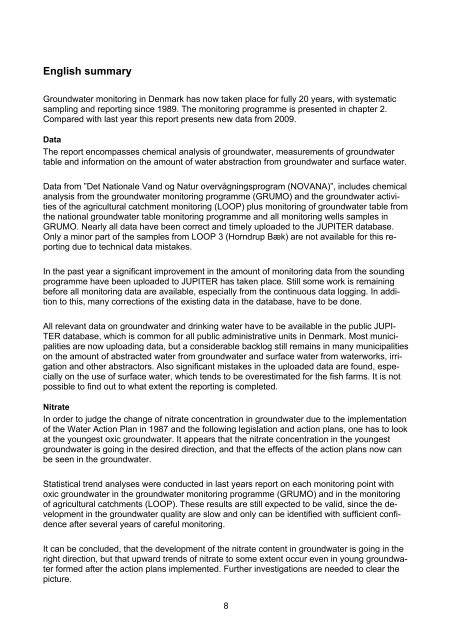Grundvandsovervågning 2010 - Geus
Grundvandsovervågning 2010 - Geus
Grundvandsovervågning 2010 - Geus
Create successful ePaper yourself
Turn your PDF publications into a flip-book with our unique Google optimized e-Paper software.
English summary<br />
Groundwater monitoring in Denmark has now taken place for fully 20 years, with systematic<br />
sampling and reporting since 1989. The monitoring programme is presented in chapter 2.<br />
Compared with last year this report presents new data from 2009.<br />
Data<br />
The report encompasses chemical analysis of groundwater, measurements of groundwater<br />
table and information on the amount of water abstraction from groundwater and surface water.<br />
Data from ”Det Nationale Vand og Natur overvågningsprogram (NOVANA)”, includes chemical<br />
analysis from the groundwater monitoring programme (GRUMO) and the groundwater activities<br />
of the agricultural catchment monitoring (LOOP) plus monitoring of groundwater table from<br />
the national groundwater table monitoring programme and all monitoring wells samples in<br />
GRUMO. Nearly all data have been correct and timely uploaded to the JUPITER database.<br />
Only a minor part of the samples from LOOP 3 (Horndrup Bæk) are not available for this reporting<br />
due to technical data mistakes.<br />
In the past year a significant improvement in the amount of monitoring data from the sounding<br />
programme have been uploaded to JUPITER has taken place. Still some work is remaining<br />
before all monitoring data are available, especially from the continuous data logging. In addition<br />
to this, many corrections of the existing data in the database, have to be done.<br />
All relevant data on groundwater and drinking water have to be available in the public JUPI-<br />
TER database, which is common for all public administrative units in Denmark. Most municipalities<br />
are now uploading data, but a considerable backlog still remains in many municipalities<br />
on the amount of abstracted water from groundwater and surface water from waterworks, irrigation<br />
and other abstractors. Also significant mistakes in the uploaded data are found, especially<br />
on the use of surface water, which tends to be overestimated for the fish farms. It is not<br />
possible to find out to what extent the reporting is completed.<br />
Nitrate<br />
In order to judge the change of nitrate concentration in groundwater due to the implementation<br />
of the Water Action Plan in 1987 and the following legislation and action plans, one has to look<br />
at the youngest oxic groundwater. It appears that the nitrate concentration in the youngest<br />
groundwater is going in the desired direction, and that the effects of the action plans now can<br />
be seen in the groundwater.<br />
Statistical trend analyses were conducted in last years report on each monitoring point with<br />
oxic groundwater in the groundwater monitoring programme (GRUMO) and in the monitoring<br />
of agricultural catchments (LOOP). These results are still expected to be valid, since the development<br />
in the groundwater quality are slow and only can be identified with sufficient confidence<br />
after several years of careful monitoring.<br />
It can be concluded, that the development of the nitrate content in groundwater is going in the<br />
right direction, but that upward trends of nitrate to some extent occur even in young groundwater<br />
formed after the action plans implemented. Further investigations are needed to clear the<br />
picture.<br />
8

















